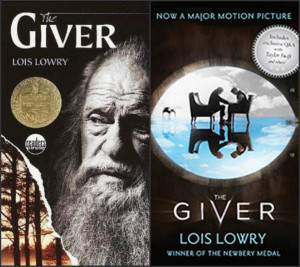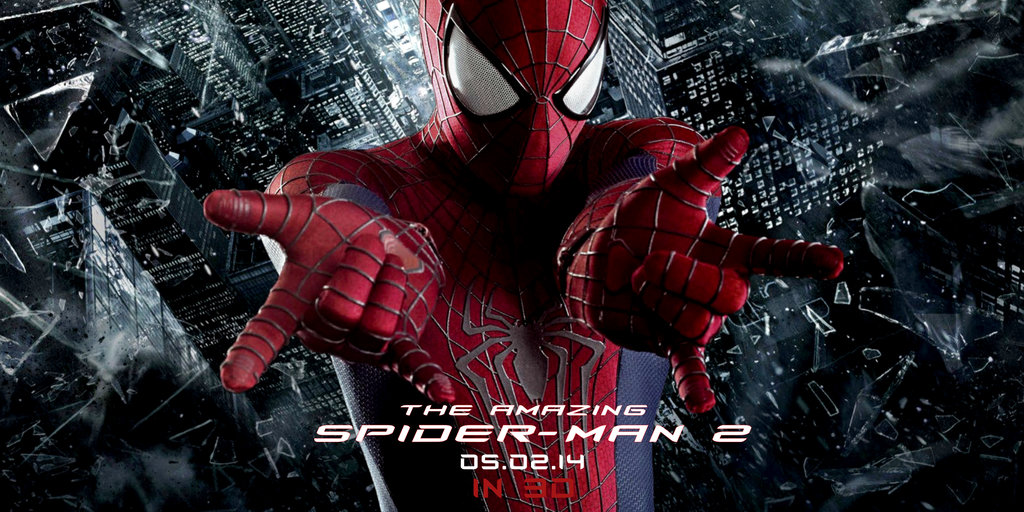Chad and Aaron Burns are the Director/producer team behind “Beyond the Mask” a Christian action/adventure film. It’s the story of a pre-Revolutionary War era assassin who worked for the East India Company, but when his employers betray him his life is saved by a cleric who dies in the process so he takes the priest’s identity as an opportunity to start a new life. Sounds fun doesn’t it? Listen to the interview and GO BUY YOUR TICKETS NOW! [podcast]http://www.podtrac.com/pts/redirect.mp3/www.williamhadams.com/wp-content/uploads/2015/03/Ep02-Chad-and-Aaron-Burns.mp3[/podcast]
Will Adams Blog
A Mellinial Creative Professional doing my best to follow Christ
The film “Beyond the Mask” and why you should go see it.

I’ve never been intimidated to do an review for a big Hollywood film because I have no illusion that anyone involved with that kind of movie would ever bother reading my review. But since I sat down with the Director/Producer team for Beyond the Mask, Chad and Aaron Burns, for a podcast interview (posting next week on the Brio Podcast) there is a possibility that they’ll see this, leaving me humbled in my attempt to review it.
This movie has a different distribution model whereby viewers have to buy tickets first and then the movie will come to their area. So you have to GO BUY your tickets NOW. I’ll be trying to get a group up to go see it here in central AL if you’re local, see the details at the end of this post.
The first thing I want to say is this: You should go see this Movie. I will say that to whomever will listen. Not because it will change your life or because it’s the best movie ever, but because if this movie has any measure of success then Chad and Aaron will make more films like it and they will get bigger and better. DeVon Franklin, a Christian Filmmaker who spoke at the International Christian Media Convention in Nashville last month, made an excellent point about this. He said that if Christian films are to ever achieve the scale and quality that we want them to be, we have to start voting with our pocketbooks; the more we go see films that reflect our values, the more the Hollywood machine will want to honor those values.
I didn’t go see God’s Not Dead, because frankly I’m not sure what movies like it hope to accomplish. They’re primarily reaching the people who are already plugged into a church and they don’t appear to be very entertaining. Having said that, making films is hard. I don’t think most people realize how much an accomplishment it is to have a produced a film with few noticeable production errors and a comprehensible plot, let a lone get it distributed and marketed to the point that the investors can at least break even. There’s no artistic medium quite like it, wherein you have to have millions of dollars to make a project happen. So I do not fault the folks at Pureflix for trying their best with what they have.
The Plot (a few spoilers here)
This film is a historical fiction. Like Ben Hur, the course of the plot follows characters who could have existed and just didn’t make it into the history books. The story centers around William Reynolds, an assassin who is finishing his contract with the East India Company. When he returns to Great Britain after what he thinks is going to be he last job he’s betrayed by his employer, Charles Kemp, played by John Rhys-Davies who is best known for his roles as Gimli in Lord of the Rings and Sallah in Indiana Jones.
Kemp attempts to kill Reynolds, but a traveling vicar manages to rescue Reynolds. The vicar dies in the process, but Reynolds takes the opportunity to start anew by assuming the identity of the dead clergyman. Reynolds travels on to the Vicar’s would-be new parish where he meets the beautiful Charlotte. Over a brief montage Reynolds and Charlotte fall in love, she believing him to be a pastor. Eventually one of Reynolds’ former assassin colleagues shows up and makes an attempt on his life. Reynolds kills him in the struggle.
Believing the last vestiges of his old life to be vanquished, Reynolds pursues marriage with Charlotte who insists he meet her uncle first. In walks, (BUM BUM BUUUUUUUUM) Charles Kemp, Reynolds’ former employer! Reynolds flees, this time aided by Charlotte’s servant, who is killed in the process and manages to give us a small heaping spoonful of the Gospel before he buys the farm. (Can this guy make an escape without a christian dying?)
Then we hit a time jump several months forward. Charlotte, Kemp, and (unbeknownst to them) William Reynolds have all moved to the American Colonies. Kemp, we find out, is part of a plot to stop the Colonies from declaring their independence. Meanwhile Reynolds has started working at a newspaper – the newspaper – the one run by Benjamin Franklin. Franklin is, as he’s often portrayed in films like 1776, a source of joviality as he offers both wisdom and comic relief. Reynolds, hearing about Kemp’s plot, puts on a mask and rides around the colonies thwarting Kemp’s every move. This culminates when Reynolds stops an attempt on George Washington’s life, but ends up being framed for the attack. Charlotte visits him during his imprisonment and they talk about Reynolds’ new found faith in Christianity through all this. They escape and prepare for the final confrontation with Kemp.
The Good & The Fun
Aside from everything else, this movie is actually pretty fun. It starts off en medias with an old map – I’m a sucker for old maps and en medias storytelling – and we immediately get a scene of two assassins taking out a ship-load of men from afar.
The fight sequences and action scenes in this film are really fun to watch. The consideration that was taken for the various fighting styles of the day is clear in the great technical approach to all of the fight scenes. The “priest-fu” action scene where Reynolds fights his former assassin partner in his clerical gear is a pretty great fight scene and the action sequences in the colonies are real fun as well. I’d say the film is worth going to see just because of these scenes.
The computer generated imagery in this film is phenomenal. Aside from the fact that it is the first Christian film to utilize this scale of CGI, it actually looks really good and works for the film. This is a huge deal and it begins to open up the door for many more films like this one to add scale and believability to their productions, but my readers won’t be shocked to hear me say that I’m most excited that it also opens up the door for more fantastic elements showing up in Christian films. (Hey Chad, if you’re reading this, have you ever read Frank Paretti’s book This Present Darkness? Cause I’ve got a connection to the guy who has the movie rights to it. . . just an idea.)
The art direction, set design, costumes et al were really solid in this film. These are elements that you often don’t notice if they’re done well, but can ruin a film very quickly if done poorly. We’re so used to big-budget period pieces nowadays that we don’t give a single thought to the fact that sets had to be built, costumes had to be sewn, someone had to think is everything that appears in the ‘mise en scene’ something that could appear in the 1770s? I’m not a history buff, but to me I wasn’t taken out of things by the look or feel of the film which is a big accomplishment by itself.
There’s explosions too and the ending has a really great sword fight, but I don’t want to spoil it for you.
The Cast
I have to say that the casting and acting in this film is good. Many Christian films are hurt by poor casting (they often just get whomever is available) and bad acting. The cast members do a great job of conveying their characters through an action/adventure film that could’ve easily been cheesy, but instead comes off pretty well through the film.
William Reynolds is played by Andrew Cheney, who has mostly just been in other Christian films up to this point. He does a good job of handling the character. Yes, there are a few moments where his performance could’ve been more nuanced, but this was new territory for him, and he did a great job in that role. He plays the character believably and the audience likes him. (something Hayden Christensen never accomplished) He does good work in the fight scenes as well.
The person I’m excited to see in this movie is the female lead, Kara Kilmer, and not just because she’s a lovely lady. (side bar here,) I first came across Kara when I watched a few episodes of Hulu’s reality show If I Can Dream, a Real World knock-off wherein all the people in the house are trying to “make it” in the entertainment industry. I went back and re-watched an episode before writing this review and I do not recommend that show, I can’t believe I ever watched any of it. Kara was the one shining light in the midst of a lot of sleaze. Where all the other cast members were cursing at each other and taking almost any part that was offered to them, Kara was really looking to do good quality work while being a Christian. There was an entire episode that centered around her decision to reject a part because it required nudity. She said “My faith effects the decisions I make about my body.” It was a real struggle for her because she turned down her first real role because of it. She was highly criticized for it by the other folks on the show including a director that accused her of wasting time by bothering to audition. I have to say it worked out for her, she’s now on Chicago Fire, and is the only person from If I can Dream who seems to have really “made it.” Congrats, Kara, you rock. (end side bar)
Aside from her allowing her faith to inform her career choices, Kara also is actually a good actress and every scene she’s in is better for it.
The stand out in the cast is John Rhys-Davies, who is the only really recognizable face in the bunch. He helps bring some gravity to entire project and, playing the villain, helps make the threat to our hero seem real. Chad and Aaron said in our interview that he was fun to have on set, having war-stories from his vast library of work.
The supporting cast is all excellent as well. I really can say that there isn’t a weak one in the bunch. And I mean that. People who know me know that I can be pretty critical of acting quality in a film, but the dramaturgy (it’s a word, look it up) in this film is solid.
Room for Improvement
Ok, if Chad and Aaron read this I want to actually offer some constructive criticism and also say to my readers that the film isn’t perfect. I am both a student of Christian theology and of film, so I do have my own thoughts about this piece, but I do think that when the average person watches it you’ll have moments where you might think there was room for improvement.
I present these in hopes that if Chad and Aaron read this that they’ll consider it simply as it is, feedback from someone who really believes in what they’re doing and hopes that they’ll continue to work and improve. I also hope they’ll see that I realize what they’ve accomplished already is huge (much more than I have for certain) and quite admirable by itself. Having said all this, I like to be as honest as I can in my reviews so here goes.
The Christian element in this movie could be improved. I say this knowing that everyone who is trying to put overtly Christian themes in any film is blazing new trails. Whereas you can hire a fight choreographer and stunt man who has worked on a dozen films and benefit from his experience, there aren’t many films that are including this kind of dialogue, and even fewer who have done it well. As such everyone making Christian films is still trying to figure out how best to have faith elements in their film. But please keep working at it, despite what I’m about to say:
The weakest part of the film is Reynold’s conversion at the end. While the Christian elements are basically strong up to this point, I felt like this was a little abrupt story-wise. I would’ve appreciated him asking a few more questions about faith and showing a little more interest before that point as it had mainly been others talking to him about it without him having much struggle/discussion in response. Salvation is difficult to depict, however, and I applaud their efforts. The discussion on a person wearing “masks” is an interesting idea. I do think it could’ve been explored a little more thoroughly. Having said that, I really do appreciate that they obviously erred on the side of “not preachy.” That’s a big plus.
The weakest single line in the whole script is when, a scene or two after his conversion Reynolds is going to face Kemp and he simply says to Charlotte “pray for me.” I really appreciate the attempt at bringing a spiritual theme into this scene, but I think about some of my friends who have been Christians for years and how they have a hard time saying straight out “pray for me” without being prompted. For many, prayer is very personal and private, especially for a person so new in their faith. It’s an awkward and intimate thing and I think the dialogue there could’ve reflected that more rather than being so blunt. I liken this a little to a scene in a movie where someone who was just handed a sword for the first time in one scene and is suddenly using it like an expert in the next. A person who is young in their faith should almost have a scene like in a superhero origin story where the hero first gets his powers and is awkwardly breaking things, and messing up his room (e.g. either of the first Spider-man movies.)
The pacing of the story feels a little strange at times. While I wouldn’t say that the film was too short, it did come in a scene or two under the two-hour mark and I wonder if it wouldn’t have benefited from adding those ten minutes in. Personally I wanted to see more of his time working as a vicar, a funny-awkward sermon or an interaction with a parishioner to take a little more advantage of the fish-out-of-water comedy (A la Sister Act) and then a little more during his time as a masked hero in the colonies. I’d like to have seen his decision to put on the mask and some kind of allusion to the importance of it, since that is a major theme in the film.
Finally, I would almost classify this film as a steam-punk kind of fantasy – which I’m totally into, but it might bother some folks. Yes, Ben Franklin did manage to start harnessing energy and created the first battery around this time. Yes, there were assassins with primitive sniper rifles at this time, but this film requires a pretty sizable suspension of disbelief for someone who likes things to 100% realistic (or as I call it, “boring.”) If you go into this with the mind set that it’s going to be totally historically accurate then prepare to be surprised. It’s a historical fiction that reads a lot like National Treasure. It’s real fun, but if you were the kind of person who didn’t like The Patriot because of the handful of anachronisms in that film, then this might be a challenge for you.
In Conclusion
I’ll say it again, you should go see this film. It could be the first of many other movies coming out that are in the action/adventure genre, but have an explicit Gospel message in them. I will be going to see it for certain and I’d love to meet up with you.
The film is only going to come to theaters where 50-70 people buy tickets (depending on the theater) So you have to go buy tickets if you want it to come to your area. So even though the movie doesn’t come out for a few more weeks you have to go BUY TICKETS NOW. I am trying to get a group up here in Montgomery. If you’re local you can look it up on the website by clicking here, entering Montgomery AL as your city and selecting the screening on Thursday, April 9th or just click here. Bring your family, your friends, your coworkers, or whomever you can find. We need to support this film.
Mark Cathy
On this, the first episode of my new podcast, “Brio” I talk briefly with Mark Cathy, grandson of Chic-fil-A founder Truett Cathy. Subscribe to the podcast on your iPhone, iPod, iPad, Laptop, or just listen to it right here. You can listen while you walk your dog, while you make dinner, while you hit the treadmill, on your way to work, on your way to pick up the kids from school, while you lift weights, while you’re trying to fall asleep . . . This will be the first of many (I have at least seven in the bank) and I’ll be releasing them twice a week so subscribe and enjoy!
[podcast]http://www.podtrac.com/pts/redirect.mp3/www.williamhadams.com/wp-content/uploads/2015/03/Episode-1-Mark-Cathy.mp3[/podcast]
Thoughts on getting my play produced
I recently had the honor of having a play that I wrote produced as a part of the Frazer’s annual musical drama production. It was a story of a family that is dealing with their Grandfather’s dementia, and each other, during the Holidays. While I did base certain quirks within my family on certain family members, It is a fiction story. The characters are mostly made up, and this family, though it has some similarities, is far more interesting than my family.
I have to say a huge thanks to Wayne Sigler, who directed the whole thing and did a great job (as usual). I also want to thank the cast who did a great job and make the script look better than I remember it being when it was just on paper. I also have to give a big credit to Ken roach who was one of my early critical readers and who basically wrote the whole sermon in the “Christmas Eve” scene. He also made suggestions that turned into some of the best jokes in the play.
If you haven’t had a chance to look at it you can check it out right here:
I can’t say why my play was chosen, but I can say why I wrote it. In the south where most people have grown up in church, people all think they know the Christmas story. People believe they know everything there is to know about it. So instead of telling them the story they think they know, I like to tell them the same story, but in a different context. The Christmas story is that of Christ humbling himself and coming to the world. This is the story of Christ coming into the life of a family. That way there is just more of a chance for those people who think they know the story of Christ to see it through a new lens.
My family is far more boring
Most people have assumed that the story is at least semi-autobiographical. The only Characters that I’d say are truly based off real people in my life are my grandparents. My grandmother is a spunky, caring woman, who speaks her mind. My grandfather, who we have been slowly losing to dementia, was a great preacher and man of God.
The truth is that my family isn’t quite as exciting as the people you see in the play. We don’t have any food fights at our table. We never had anyone yell at the family and storm out. No one in my family frequents bars, is loose with their dating life, or has ever owned a pink gorilla costume. Despite this we do have our differences, we do have our fights, and we do have bizarre and funny eccentricities that make us, well, us.
The one thing that is 100% factual is regarding the poem in the play. I wrote a blog entry a few years ago about my grandfather and what I’ve learned from him. You can read it here. In it I talked about the Sydney Lanier poem that is featured in the story. Until recently my Granddad would repeat the poem every time that we got together. This past week when we were together for Christmas, my dad suggested that we all say it aloud, (as in the play we’d heard it so much that we all have it memorized) and my Granddad, even in his current state, joined in and said it along with us. It was very meaningful.
The character(s) based on me
Perhaps the thing that people have been saying most often to me is that the character of uncle Charlie must be based on me. I can honestly say that I didn’t write it with that in mind. I think they would be pretty surprised to find that Charlie is not that character with whom I identify the most.
I suppose there is a sense in which I’m Charlie on my best days. But the person with whom I most identify is actually the character of Anne. No, I’ve never been that ostracized from my family nor have I behaved quite as callously or unscrupulously as Anne, but the thing that I really understand in her is the feeling of not being good enough. I am the youngest in my family and as Anne said when you’re the youngest you never stop being the baby even when you’re almost 30. In addition, I’ve lived most of my life feeling like I’m not good enough, that I’m not doing enough. Some might call this an “inferiority complex” I think that inadequacy is a better word.
It’s been curious to me to find out that this is a trait of many great performers and creative people. Comedians especially talk about how they’re driven by a desire to make people like them. The late Johnny Carson, the “king of late night,” was driven mostly by a desire to prove himself to his mother, who never told him that she was proud of him. My parents were very generous with encouragement and I’m not (nor will I ever be) anything close to Johnny Carson’s level of commercial success or fame.
What this tells me is this: no amount of success (including getting your play produced for a few thousand people) will make you feel adequate, only God can do that. Resting in Christ’s “enough” is far more than the worlds best “just a little more.” Because as Pascal first said, there is a God-shaped hole in all of us. And as Andy Stanley recently said, we all have an appetite to be known and the only one that can satisfy that need to be known is God.
Enough is enough
So, I got it half right; I’m not good enough and I never will be. Neither will you. Scripture tells us that we can do all things through Christ. We usually read that scripture as if “all things” means “great things.” What if it just means “all the things we face” Apart from him we can do nothing including waking up, breathing, and interacting with the world around us. I think it’s healthier to have a perspective that reminds us of how we can’t do anything without God, this kind of inadequacy can lead to a healthy sense of dependance on him. That is the best place to live: in Christ.
At this point I’ve come to see this feeling of inadequacy as a great blessing, as I realize that it’s the truth: I’m not enough, but God’s grace is enough for me. Because I realize that day-to-day, I’ll never be without a feeling for a need with God. I now see it as a loving way that God has drawn me closer to him.
In the wake of my play being produced I’ve heard story after story of people who identify with the family in the play. They see themselves as one character or another. Many people have gone as far as to make contact with their parents or siblings from whom that had been estranged. It’s been really cool to see what God has done with this play. I’ve heard it said that if you take credit for your failures that you’re going to be tempted to take credit for your successes when you need to be willing to Give both over to God. I really feel like that this play has been a means of grace for me, as it’s given me an opportunity see God at work in and through my life, so that he can show me that I don’t have to be good enough, I just have to rely on him.
The Giver: The Best Movie that Everyone is Missing
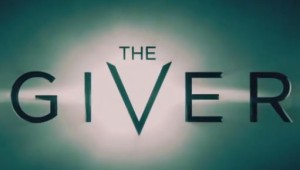
I’m going to say something shocking: The Giver might be the best movie based on a young adult book released in the past three years. Those who know me know that I’m a big fan of the Hunger Games Series and Divergent. So you must understand that I don’t say this lightly. Perhaps most interesting is the strong Christian bent there is in the story and how clear this is in the movie. Particularly to me as someone who ascribes to Wesleyan theology.
In Case You’re Not Familiar…
The Giver is a book released in 1993 that won several awards and was very popular. It was also – as all good books are – controversial among parents and educators. Some said that it was too dark in its themes. Others were concerned about the description of what they considered a “sexual awakening,” though I think they missed the whole point of the book if they think that’s what it actually was.
If you read the book, watch the movie, or just read my review and you find comparisons between this book and the Hunger Games or Divergent, know that this book predates those by more than 15 years. In some ways it was the prototypical YA novel based in a dystopian society. Though I’m glad they didn’t pull a ‘John Carter’ and alienate the fan base of those books by advertising that it was “before the Hunger Games.”
Bill Cosby actually attempted to produce the Giver in the mid 90’s and Jeff Bridges at that time wanted to be involved, though he wanted his father, Lloyd Bridges, to play the titular character. Due to the controversy and the usual Hollywood studio rigamarole it never came to fruition. Funny to think that if the book had been released today there would be a movie of it being released two years from now. 20 years ago it was possible for a good book to just be a good book.
Book vs. Movie: Cage Match
Comparing books and movies is like comparing apples with spark plugs. They have totally different purposes. When reading a book, entertainment value is often secondary to literary value, and the thoughtfulness of the piece takes precedence over how “fun” it is. While films snobs would bemoan it, the opposite is true of film. The artistic value is secondary to entertainment value. Simply put, books are a medium wherein people expect to think, while film is a medium wherein people expect to be entertained. More people are willing to pay to be entertained than they are willing to pay to think and thus movies make more money than books.
Despite all this, we know that the best books and movies are all going to be both fun and thoughtful. The Lord of the Rings, It’s a Wonderful Life, and almost all of the Pixar Films all have both of these traits. This movie is no exception, but that doesn’t mean it’s exactly like the book.
When directors, producers and screenwriters, make changes from a book to a film it’s not because they’re idiots trying to ruin your childhood, it’s just because they want to make money and they’re trying to optimize the work for that. So this is my warning for any purist who loved the novel upon which The Giver is based: don’t bother. The movie makes several huge changes to the story and shifts several other details that you may think are important. However, if you’re willing to say that perhaps the book was its own work, and that it, like every other great artwork, can stand being reinterpreted, then you can enjoy this movie.
The biggest single difference between the book and the movie is the simple fact that the third act of the story was almost totally fabricated for this movie. While there are other differences, this is the most glaring one as it makes the ending feel totally different, though it actually ends up much like the novel does. The second big difference – that has some people very upset – is that the characters are 18 instead of 12. If you’re wondering why this is, please see the first sentence of the previous paragraph. They did it because they thought it would make it more marketable. Children can’t go see movies on their own, but teens do. The movie would have to be PG-13 to accurately represent the book, and PG-13 doesn’t market to children. PG-13 is a desirable rating – just look at the top 10 highest grossing movies to date; almost all of them are PG-13. Honestly though, this has very little practical effect on the story and none that is negative. If the ages of the children are important to you then stick with the book. In fact, if that detail is really important to you, then don’t ever go see a book adapted to a movie because that’s the exact kind of detail that producers eat for breakfast.
Other differences include small details being altered that have effects on the story – Asher’s job assignment is different in the movie in order to set up conflict between he and Jonas later. Instead of being bordered by a river they’re on an enormous plateau surrounded by misty clouds on all sides. Jonas manages to convince Fiona to stop taking her medication so she begins to feel also. Even smaller details such as Jonas not using the word “apprehensive” to describe the way he feels about the ceremony. To someone who read the book they’d know that the entire first chapter Jonas spends the day toiling over what exact word to use. Then there’s the fact that instead of taking pills to suppress their emotions, they must take a computerized injection every day. Ultimately these changes are mostly good or neutral to the story. (Again, unless you’re a purist.)
Summary (here be spoilers)
The Giver is set in a dystopian future of our world. Everything seems ideal at first. There is no hunger, no war, no pain, and no poverty. The members of the community make jokes, enjoy their jobs, and live comfortable lives. As a part of this society’s peacefulness there is a heavy emphasis on “precision of language” a phrase that really means avoiding using words that are considered obsolete. (Similar to 1984) While people are friendly to each other and everything seems peaceful, somehow the world is cold, literally colorless, mechanistic and perfunctory. One of the important aspects of this is the daily injections (pills in the book) that make sure no one is capable of real emotions. They don’t feel emotional pain because they’re not capable of it. Think: Equilibrium.
People are organized into family units, though their parents are not their biological parents. In the book this is explained more clearly, but it is alluded to in the movie. One of the jobs in their society is “birth-mother” which is exactly what it sounds like. Families are assigned two children of different ages. When the children are old enough, they leave the home. When adults are too old to work, they are “released to elsewhere.” Release is mysterious process for the elderly, those who disobey the rules, or infants that do not meet the health requirements to be given to parents. Anyone can apply to be “released to elsewhere” from the community.
The film opens, like Divergent or the Hunger Games, with a ceremony. Jonas is a young man who is turning 18. This ceremony involves all the children of the community receiving commendations and new items representing their progress in the community. Jonas’ little sister is 9. She and all the other 9’s receive bikes; the method of transport in the community. They also honor the older members of the community who are going on to be released. Finally it’s time for the 18’s ceremony wherein they’re assigned their job in the community. Think: Sorting Hat meets Reaping meets Faction Choosing.
When Jonas isn’t assigned a job like the other kids, he’s 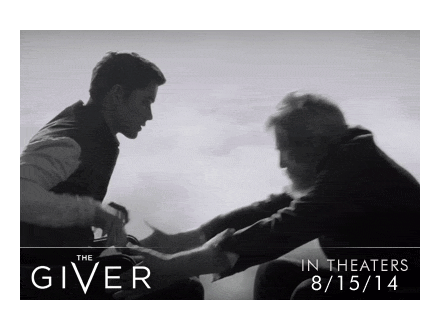 worried about what’s going to happen to him. He soon finds out that he’s been chosen for the once-in-a-generation job as the “Receiver of Memory.” The chief elder (played by Meryl Streep who has already won eight more Oscars just for selecting this role) explains that this position requires certain skills and strength. Sitting among the elders is an old, disheveled, bearded man who Jonas recognizes as Jeff Bridges, who was nominated for 17 Oscars for the work he did at lunch today, but unfortunately he only brought home one statuette. The mysterious bearded many turns out to be the current “Receiver of Memory.” Jonas shows up the next morning at the Receiver’s lonely house to start his training.
worried about what’s going to happen to him. He soon finds out that he’s been chosen for the once-in-a-generation job as the “Receiver of Memory.” The chief elder (played by Meryl Streep who has already won eight more Oscars just for selecting this role) explains that this position requires certain skills and strength. Sitting among the elders is an old, disheveled, bearded man who Jonas recognizes as Jeff Bridges, who was nominated for 17 Oscars for the work he did at lunch today, but unfortunately he only brought home one statuette. The mysterious bearded many turns out to be the current “Receiver of Memory.” Jonas shows up the next morning at the Receiver’s lonely house to start his training.
The old Receiver explains that his job is to contain all the memories of the way things were before the community was established. Having memories allows him to see color, hear music, and understand the depth and importance of emotions. Jonas can’t understand this, so the old man takes his hands and proceeds to transfer the memories into Jonas. The first several memories are all good (though in the book this is a little different.) Jonas points out that since there is only one Receiver of Memory, he doesn’t know what to call the old man and so he simply replied “The Giver.” Jonas begins to see color and stops taking his daily injections. Though for most of this time he doesn’t begin to question the structure of the community just yet.
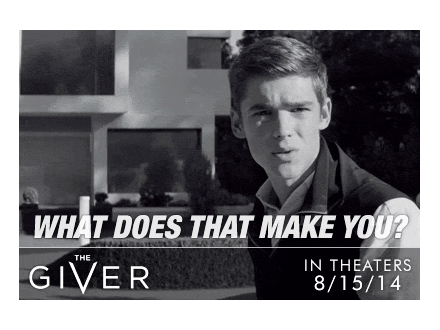
#titularLine
All during this time Jonas’ father, a “nurturer,” brings home a baby that has been labeled “uncertain.” Nurturers are in charge of caring for infants until they are assigned to their parents. This baby was labeled uncertain because he was underweight. Babies that don’t hit their target weight are released in favor of the children who are stronger. Jonas notices that the baby has the same birthmark on it’s wrist that he has. He had also seen the same birthmark on the Giver. This signifies that baby “Gabriel” has the same ability to “see beyond” as both Jonas and the Giver, Jonas supposed that one day baby Gabriel might replace him.
Jonas, becoming more reckless, convinces his friend Fiona, a pretty girl who’s hair he can now see is red, to stop taking her injections. This is a big departure from the book, but it allows Jonas some companionship when she arrives the next day confused and upset and she begins to realize that there is something very wrong with their community.
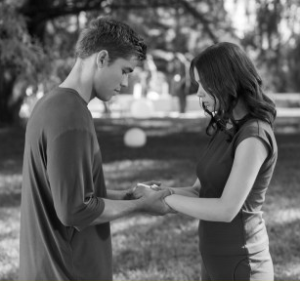
One day as Jonas enters the Giver’s house, the Giver is writhing in pain on the floor and as Jonas helps him up he accidentally receives the memory of war. This is upsetting and for a moment he doubts if he has the strength to carry on, but eventually he returns to find the Giver watching a hologram of he and a girl playing the piano together. The girl (a cameo role by Taylor Swift, who is only a little distracting) was the last one selected to be the receiver of memory. The Giver reveals that after receiving a memory regarding great loss that Rosemary applied for release.
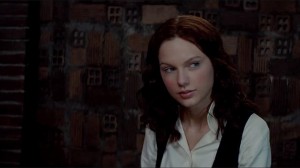
Taylor is that you? I can’t tell without your massive amount of eyeliner.
Things come to a head when Jonas acts as if release is nothing to be feared, but the Giver shows him a hologram of what release truly is: euthanasia. Jonas watches in horror as his father gives a shot to a baby simply because it was the lighter of two twins. Twins are not allowed in their community. This is the turning point for Jonas and he realizes that they’ve been murdering babies, disposing of the old, and killing off any rule violator his whole life. Because of the injections they don’t even understand the pain and value of life that they should be taking in. Jonas’ outlook on his family changes drastically. 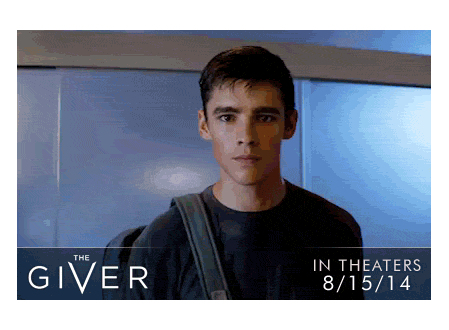
Jonas and the Giver, now in agreement that things must change, devise a plan that Jonas will leave the community and go until he reaches the “memory barrier.” This device is added for the movie and actually helps explain the ending A LOT. The memory barrier circles around the outer boarders of the community. It’s created by towers and makes it so that anyone inside the barrier cannot remember the world outside. By leaving with all the memories, Jonas will break the barrier, releasing all the memories so that everyone back in the community will suddenly remember everything.
Jonas returns to his family unit’s dwelling to discover that baby Gabriel has been returned to the nurturing center to be released as he hasn’t reached his target weight. Knowing now that release means death, Jonas breaks the rules and goes to rescue Gabriel, stopping at the Giver’s house to tell him that he’s leaving the community that night.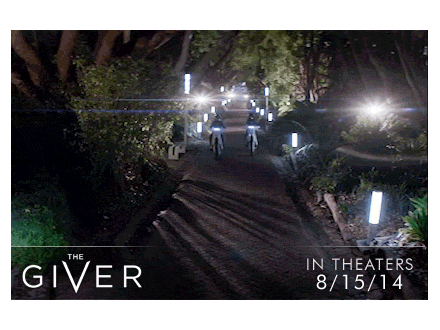
I’m not going to spoil the ending for you, especially if you have read the book, because it’s gives much more detail about what happens after Jonas leaves the community and that’s the fun part.
The Production
My biggest beef with the movie’s over all production was more with its writing than anything else. I thought that the adaptation was good story-wise, but it was weak in some of the dialogue. For a story that emphasizes precision of language I felt there were a few missed opportunities to lift exactly from the book the words that were used. I also thought that more could be done to illustrate how the society worked, making it clearer that by all appearances, everything is okay at the beginning of the story.
Perhaps the weakest point of the writing was the fact that they include narration. Narration is often added by producers after a movie is near completion (as in the case of the theatrical cut of Blade Runner), so it may not be their fault. Narration in movies is considered weak because it’s not taking advantage of the visual medium. Now you may recall that I didn’t mention this in my review of Divergent, which included narration just at the beginning. The difference is the efficiency of use. The narration in Divergent was only at the beginning to set up the world, and it was both telling and showing. The same is true of the narration at the start of Lord of the Rings: The Fellowship of The Ring.
In The Giver, narration is used as a crutch throughout the film to fall back on when the producers are worried that the audience might not get it. It weakens the over all impact because it gives you the impression that Jonas has already experienced everything that we’re seeing and as such, there’s no real danger to feel because we know the whole time that he’s survived.
However, this movie is amazing from a cinematic production standpoint. If it doesn’t get nods for both cinematography and visual effects then there is no justice.
The first quarter of the film is totally black and white. As Jonas awakens to the depth of emotions, memories and the human experience color begins to slowly creep in. This is actually one of the most interesting things that the book tries to describe. I say tries because color is inherently visual and no amount of words can explain colorlessness, colorfulness, or any gradation there between. Ultimately this is the single most impressive aspect of the production and while I can describe it to you all day long, as I’ve said it must be seen to really be appreciated.

The Cast
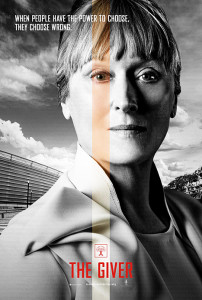
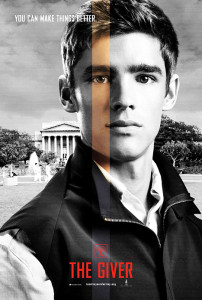
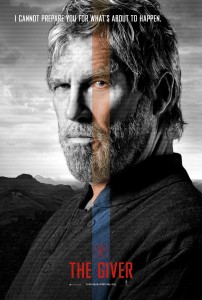 The first people that will come to mind for anyone seeing the trailer will be Jeff and Meryl, but the main character is solid as well.
The first people that will come to mind for anyone seeing the trailer will be Jeff and Meryl, but the main character is solid as well.
If you’re upset with the fact that Jonas is older, I I think you can still enjoy Brenton Thwaites’ performance. He’s actually a solid actor and plays a likable and relatable character despite the fact that he’s in a strange, futuristic world that we shouldn’t be able to relate to at all. While he’s not going to be nominated for an Oscar, I think he brought a lot to the table. Any concerns I might’ve had about making Jonas older were quelled as soon as I saw him playing this role.
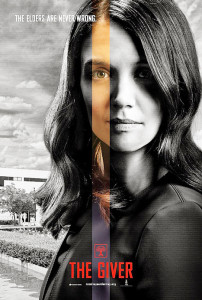
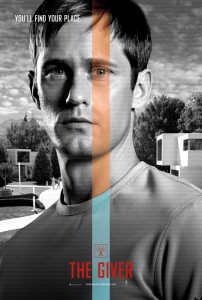
Beyond that we have an excellent cast of supporting characters. Katie Holmes, I know, has received mixed reactions for her role in Batman Begins. I didn’t hate her in that, so maybe I have Holmes-blindness, but I thought she did a good job as Jonas’ mother in this, perhaps though she’s best suited to play an emotionless, unfeeling shell of a human being. Hm. Not sure. But regardless she played her part well. Then there’s Alexander Skarsgård. Who you may know from nothing. That’s not a film title, you actually know him from nothing. You may say “didn’t I see him in?” No, not likely. Ok that isn’t fair, he was in Battleship and True Blood. Did you watch either of those? No? Okay. That’s what I thought. Anyway he’s good too as Jonas’ father. 

Next we have Cameron Monaghan as Asher, if there was a weak one in the bunch it’s probably him. I’m not sure if it was because of the dialogue that was written for him or if his performance was truly sub-par, but he wasn’t all he should’ve been for whatever reason.
Odeya Rush plays Fiona. I respect the casting director for not going with a bigger name for this role. While miss Rush has made a career out of playing creepy little girls, she hasn’t been tested in this kind of part. She did well in adding some feminine hart to the story that focuses on two dudes for most of the time.
And finally we have that little cameo from Taylor swift. Her role is pretty tiny really, and not at all jaw-dropping. The part of Rosemary is important to the story, but she doesn’t actually appear in person in the book, and the way they put her into the movie was such that anyone could’ve played the role equally effectively. I’m not getting at Taylor, she may be a great actress, but this part didn’t show any range to speak of, it seems odd to me that they would insert her into such a small role that just as easily could’ve been played by another small-name or no-name and probably just as effectively. However, it’s clear based on their marketing that the goal was to get teenage girls in to see this movie. Why else would such a small role get her own poster? So I guess what I’m saying is, you should go see this movie, but not because Taylor Swift is in it.
swift. Her role is pretty tiny really, and not at all jaw-dropping. The part of Rosemary is important to the story, but she doesn’t actually appear in person in the book, and the way they put her into the movie was such that anyone could’ve played the role equally effectively. I’m not getting at Taylor, she may be a great actress, but this part didn’t show any range to speak of, it seems odd to me that they would insert her into such a small role that just as easily could’ve been played by another small-name or no-name and probably just as effectively. However, it’s clear based on their marketing that the goal was to get teenage girls in to see this movie. Why else would such a small role get her own poster? So I guess what I’m saying is, you should go see this movie, but not because Taylor Swift is in it.
Christian Themes
The whole point of the book, to me as a Christian, is an explanation for the problem of pain. If you’re not familiar with it, the problem of pain or problem of evil (different problems, but two sides of the same coin) is the question of why, if God is loving and all-powerful, would He allow for such great pain to be possible. There are many good answers to this question that Christians have used to answer it logically, but ultimately the problem of pain is an emotional one that cannot be answered with logic.
The Giver seems to offer that if we were to find a way to get rid of pain we’d also have to get rid of love and ultimately get rid of choice. That’s when we realize that for great love and freedom to exist, the possibility of great pain has to exist also. When Meryl Streep’s character, the Chief Elder, assesses “when people choose, they choose wrong.” She is explaining why a society would come to a place where they would ultimately remove choice from the equation and remove one’s desire for anything but efficiency and preservation of continuity.
While pain is terrible, living a life without it means that we cannot tell right from wrong. It’s like C.S. Lewis says:
“Pain is God’s megaphone to a dying world”
– C.S. Lewis
We get an up-close look at a world without pain in The Giver and it’s terrifying. It results in the killing of innocents and loss of an understanding of the value of life.
The other obvious issue is abortion. If you’re wondering why this movie didn’t get good reviews, it had nothing to do with the acting or the production. This movie had a subtle, but somehow still very strong anti-abortion message woven into it. The idea that the only way to get rid of evil is really to get rid of our understanding of evil is entirely accurate and it results in our voluntary ignorance when we consider the controversies. Instead of trying to discern the truth, we do what is the most efficient thing for us, while ignoring the reality of killing children.
Final Thoughts
I don’t want to build this movie up too much. It isn’t prefect. It raises questions (why and how would a society that can’t see color bother having color-coded uniforms for workers?) You may find it cheesy in places. you may find it weird. You may just not get it. It may get reviewed out of the theater before you even get a chance to catch it. It may be a blip on the cultural radar, and likely will be less than a blip. But I will say that I believe that not only is this the best YA movie of recent years, it might be the best christian movie since the Voyage of the Dawntreader.
And oddly, though the reviewers on rotten tomatoes only gave it a 30%, somehow the users reviewed it at 70% so normal people without an agenda seem to like it a lot. I give it a 4 out of 5 stars and highly recommend catching it in theaters.
What I want to hear God say.
I always enjoyed watching Inside the Actors Studio when I was in high school. My mom being a theatre teacher, we always listened to actors pretentiously explain their craft while they were adored by the majestic James Lipton. I especially liked the length of the interview which allowed the actor to cover more ground than they might in a normal talk show. As much as I made fun of it, I did enjoy the show and I really appreciated Lipton’s love of performers of any genre and background. Every episode, no matter if he was interviewing Ian McKellen or Desmond Diamond, Mr Lipton ends with the Pivot Questionnaire. The last question on the survey was, “If Heaven exists, what would you like to hear God say when you arrive at the Pearly Gates?”
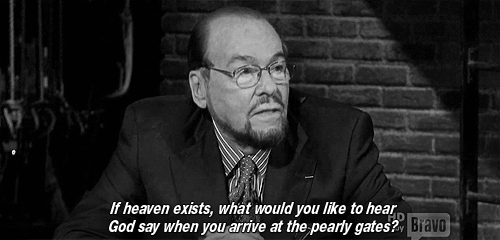
I hadn’t thought too hard about this because I basically knew the answer and I think many Christians would say the same thing: “Well done my good and faithful servant.” I’ve always identified with the idea of servanthood to a worthy King. I’ve rarely had trouble finding myself aligning with that metaphor for our role in Christ’s kingdom. But recently it came alive for me in a new way.
What’s Tom Hiddleston doing on my blog?
I was recently listening episode of a podcast that featured an interview with Tom Hiddleston. If you know of Tom Hiddleston, it’s probably from his role as Loki in the Avengers movies. If you’re not a Marvel fan, you may know him from his role in Steven Spielberg’s War Horse. In this interview Tom talked about what it was like to work with Spielberg. The interviewer compared it to the scene at the end of Amadeus in which Mozart is dictating his final piece to Salieri. Salieri says that it was as if Mozart was receiving the music directly from heaven. Hiddleston said that watching Spielberg set up a shot was amazing. He said that he was a true master, but that the most amazing thing about him wasn’t his talent, his knowledge, or his creativity. The first thing about Spielberg that impressed Tom was how humble the great director was. Specifically, Tom recalled one scene in which his character was alone on camera. It was a scene that was especially difficult, emotional, and intimate. Spielberg dismissed the camera crew and asked Tom if it was alright if he operated camera. Hiddleston agreed of course. After the first take Spielberg had a few notes for him. And Tom agreed and they moved onto take two. After take two Spielberg lit up and said that it was perfect and he started to move on. Hiddleston stopped him and asked if he could do a third take. Spielberg told him he didn’t need to, that the second take was good, but Tom pleaded with him and said that he could do it even better now that he knew what Spielberg was looking for.
They shot the third take and when it was done Spielberg just said, “Take two was pretty good.” He seemed pretty unconvinced. When they wrapped for the day Spielberg told Tom that he would be reviewing the footage this weekend and that he would let him know what he went with. The next Monday when Tom came to set, he saw Spielberg who simply said, “Tom, take three’s in the movie.” He proceeded to emphasize what an honor it was to have contributed even in a small way to the master’s work.
Everyone is Creative…yes really
I’m a strong believer that “uncreative people” simply do not exist. There are only people who haven’t discovered their brand of creativity. Some people are creative in their hospitality, other people are creative with financial management. Some people are creative with physics and chemistry, other people are creative in their encouragement. Not everyone is artistically creative, but everyone is creative in some way. How you choose to use that creativity will determine the focus of your life.
So my question is: are you settling for take 2 – just doing whatever is the “right thing” to do – or are you asking for take 3? Take 3 looks like a group of medical professionals donating their time to people in their community who can’t afford healthcare. Take 3 looks like men who choose to spend their retirement building wheelchair ramps for people with disabilities. Take 3 looks like a successful TV director going to work at a Christian school so he can ensure there are skilled Christ-followers in the entertainment industry. Take 3 looks like a college student who spent his saturdays teaching impoverished children how to sing Christ’s praises. Take 3 looks like a husband who doesn’t hesitate to give his wife a kidney. Take 3 looks like a family adopting a child when they already had two, three, or four children. Take 3 looks like empty nesters making themselves available for foster and respite care. Take 3 looks like a teenager taking his free time to lead a small group of his peers. Take 3 looks like a young man who starts a non-profit to support an orphanage in africa. Take 3 looks like a church that starts a free clinic in their community. Take 3 looks like people who take a day off to help build a house for people who need a fresh start. Take 3 looks like a father picking up the pieces of a shattered life and doing the hard work of teaching his daughter what he was never taught by his parents.
What I want to hear God say.
So for me, as one of these creative people, I just want to know that I’ve been able to contribute to the master’s work. I want to hear God say, “Will, take 3’s in the movie.”
Thanks for reading. Please like and share.
X-Men Days of Future Past: A Review (spoilers, but just read it.)

If you’re a fan of the X-Men comic books this is the movie you’ve been waiting for. If you’re a fan of the X-Men TV show this is the movie you’ve been waiting for. If you’re a fan of the other X-Men movies this is the movie you’ve been waiting for. If you’re a fan of the X-Men line of chia pets… you get the picture.
If, however, you don’t like time travel, you’re not going to like this movie. If you don’t like the X-Men, you’re not going to like this movie. If you can’t suspend reality enough to enjoy a Sci-Fi/Fantasy action film, you’re not going to like this movie. If your favorite X-Men movie was “The Wolverine” because of it’s much more character driven and has a somewhat realistic plot with only three mutants in it… you’re not going to like this movie.
I started my understanding of the X-Men with the 90’s cartoon on Fox TV. It was a controversial show among Christian mothers; I think someone at Focus on the Family had probably written a article about it. The issue that my mom had with the show was that it wasn’t always clear who was good and who was bad. For me, I never had trouble understanding that X-Men wasn’t as much about the typical super hero plot, represented recently by The Amazing Spider-Man 2 (reviewed here), wherein the Superhero gains powers, encounters tragedy, makes a vow to fight for good, fights bad guys – usually one to three individuals at a time who also has super powers and by defeating that one bad guy he saves his city who is typically very grateful. I like this formula, but the thing that is appealing about the X-Men is that it isn’t about that formula. It almost isn’t accurate to classify the X-Men films as “superhero movies” as they so totally break the mold. The X-Men stories are about the larger society, prejudice, fear, and how to be diplomatic in complex situations.
The Morality of X-Men is confusing and often changing according to who is a greater threat. Here’s my own take on it with a little help from our friends over at Dungeons and Dragons. Putting Magneto at “true neutral” is because of the aberration in the pattern of his actions. Half the time Magneto seems to be a team player, joining up with the X-Men to fight a greater evil, but the other half he’s trying to destroy humanity in an effort to establish mutant superiority. When you see his history, you understand why this seems logical, and it is done out of a sincere desire to help mutants. He also comes around in the end, as we see in this movie.
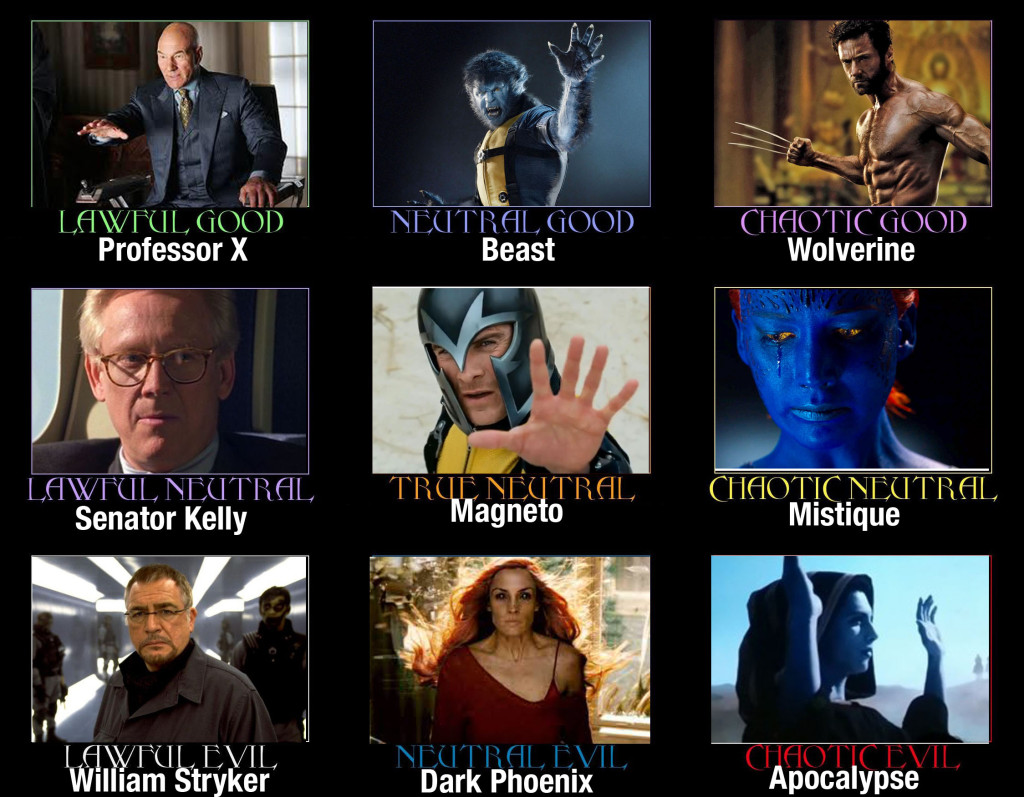
I don’t want to over-hype it. It’s certainly not perfect. I’m not slapping any hyperbolic labels on it like “best superhero movie ever” or “best movie of summer.” But I might call it the best X-Men movie so far, if for no other reason than the fact that it bridges the continuity (or lack there of) between the original trilogy and First Class while paying it’s respects to the Wolverine films. Undoubtedly there will be many questions about this film as it relates to the others, but those details aside I think anyone who has seen and enjoyed the other films can enjoy this one. If you haven’t seen any of the X-Men films I want to say now DO NOT SEE THIS MOVIE. It will confuse the daylights out of you. It will probably confuse you a little if you have seen the X-Men movies, but at least you have some idea of who the characters are before you launch into multiple time-lines and young/old versions of characters. Rewatching X-Men 2, 3, and X-Men First Class would be helpful, though it will raise a few questions that I’d be glad to discuss with you at length because I don’t have anything better to do.
Before I launch into a synopsis, I want to emphasize that if you’re not a fan of time travel tales that you will not like this movie. This is a film that hinges on time travel and I know there are some people who are simply bothered by the impossibility and seeming arbitrary rules of time travel in any given movie and this film is no different. It is very wibbly wobbly. By contrast I know many people who love time travel movies. I’m one of them. Part of this has to do, honestly with my view of God as being outside of time. I see God as a being for whom everything is currently happening, everything has already happened, and everything will happen soon. I often like to think about the possibility that heaven exists outside of time and what does that mean for our eternity with Christ?
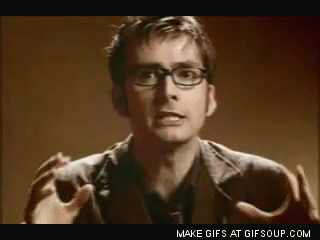
It’s a ball of wobbly wobbly…timey-wimey…stuff. #DrWhoReference
As much as I would love to break down all the issues that time travel creates for this and the other six movies, both time-line and continuity wise, our buddies at Entertainment Weekly are paid to do this stuff, so if you want a fairly comprehensive article on the time line as well as some othe details of the plot you can read their article here. Aside from the usual illogical hatred for X-Men 3, I agree with most of the theories there. But let’s talk about the movie by itself and what actually happens.
The Plot

Xavier’s ALIVE?
Ok this is going to be confusing. We open in the not-too-distant future where we see several of our friends last seen in 2006’s X-Men: The Last Stand, Shadow Cat (played by the now much more recognizable Ellen Page), Ice Man, Colossus, and a few new faces including a more obscure X-Man named Bishop. The first fight is just a couple of minutes in, and it might actually be the best fight in the film. Sentinels show up and kill almost everyone except Shadow Cat and Bishop who run to a back room where shadow cat uses her secondary mutation (made up just for this movie) and she sends Bishop’s mind back in time and everything disappears. At this point if you’re watching for the first time and don’t just know that’s what’s happening, you’re just not going to know what’s happening, especially when we go to the next scene and all the people we just watched die are still alive. While you’re still confused a new version of the Blackbird lands somewhere. Out of the jet comes Old Magneto, Storm, Old Wolverine, and Old Professor X. If the last thing you saw was X-Men 3, it might be a surprise to you to discover that Xavier is still alive.
If you’re worried that they’re going to give some half-baked comic book explanation of exactly how Xavier survived after being vaporized by Dark Phoenix in X3, don’t worry, because they don’t try to explain it at all. Instead they rely on you to have watched the after credits scenes in both X-Men The Last Stand and last year’s The Wolverine. Which gives you the detail that Xavier apparently transferred his consciousness into the body of a brain dead man and then reveals himself to Wolverine. They never bother explaining why the brain dead man looks like the old Xavier or why the legs of this body don’t work either. Oh well. You’re just going to have to accept that he’s back.
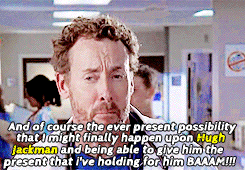
when listing the two things that get him out of bed in the morning…
What’s even more confusing is the X-Kids’ explanation of what happened in that first scene. Apparently every time the Sentinels (giant robots that operate like the T-1000 from Terminator 2.) find them, Shadow Cat sends bishop back in time a couple of days to warn them. They then move their location so that they’re never found. If you followed that, you should have no trouble with the rest of the plot. Xavier then suggests they send someone back in time further and stop this war from starting. Shadow Cat says that she can only send someone a few weeks back in time without scrambling their brain. That’s when the movie-making machine at Fox stepped in and said, “yes but our big star is Hugh Jackman and he has the ability to heal.” And we, the public, have no problem with that because everyone but Dr. Cox loves Hugh Jackman.
That’s Right, because Wolverine can heal faster than anything can kill him, he volunteers to have his mind sent back in time into his younger body (conveniently played by Hugh Jackman because, as Shadow Cat reminds us, Wolverine doesn’t really age.) So after it’s made clear that if they’re caught by the sentinels this time that they’ll have no way out (as Shadow Cat will be occupied with Wolverine’s brain) they send Logan back in time.
There’s a random scene in which Wolverine is naked and we see his butt. I mention this because for one of my friends this was the reason he was worried about taking his kids. So there you go. It happens. It’s like four seconds.
Logan goes to the X Mansion where we find out that the young Professor X is depressed and is taking a drug that allows him to walk, but suppresses his powers. Beast is there also – he had developed said drug to hide his own mutation which actually kind of neatly alludes back to the Dr. Jekyll and Mister Hide reference made in X-Men First Class. Somehow Logan manages to convince professor X, not only that he’s from the future and needs their help, but also that they need to break young Magneto out of jail for… you know… reasons… Ok so, story-wise it doesn’t totally make sense except for the fact that this is what future Eric and future Charles tells him to do.
They go get Quicksilver, who is actually Magneto’s son – as is revealed in a small offhanded comment by Quicksilver. After wolverine says that they’re trying to break out a “guy who controls metal” Quick Silver says “my mom used to know a guy like that.” Which just gives enough of a nod to make us aware that Brian Singer is going with that version of the story. (Something that was lacking in X2 in the scene between Nightcrawler and his mother, Mystique – who doesn’t seem to think it necessary to mention to anyone that Nightcrawler is her son.)
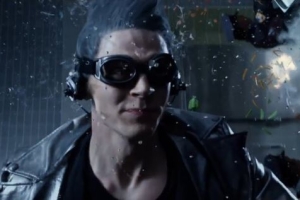 Quicksilver gives us an awesome scene in which they break magneto out of prison. Perhaps the most visually impressive scene in the movie is when we see Quicksilver’s point of view as he dispatches with a room full of guards by running around the walls while fire sprinklers have been set off. The scene is in slow motion except for Quicksilver. The water is falling slowly, bullets flying slowly and everyone reacting slowly as he darts around the room, knocking over several guards and pushing bullets out of the way. Then Quicksilver leaves because this movie has too many characters to spend any more time with him. Don’t worry we get one little clip of him watching TV with his little sister (Scarlet Witch?) And undoubtedly he’ll be in the next movie.
Quicksilver gives us an awesome scene in which they break magneto out of prison. Perhaps the most visually impressive scene in the movie is when we see Quicksilver’s point of view as he dispatches with a room full of guards by running around the walls while fire sprinklers have been set off. The scene is in slow motion except for Quicksilver. The water is falling slowly, bullets flying slowly and everyone reacting slowly as he darts around the room, knocking over several guards and pushing bullets out of the way. Then Quicksilver leaves because this movie has too many characters to spend any more time with him. Don’t worry we get one little clip of him watching TV with his little sister (Scarlet Witch?) And undoubtedly he’ll be in the next movie.
A trivial aside: many of you will be confused at this so I’m going to say it now in hopes that maybe you’ll remember it later. In Avengers 2 there will be a totally different iteration of “Quicksilver” and “Scarlet Witch.” They were introduced post credits after Captain America: Winter Soldier. These are the same comic book characters, but they are in different cinematic universes and are played by different actors. That is because there is a difference between movies made by Marvel and movies licensed by Marvel. All the characters in X-Men are licensed to Fox. That is why it is very unlikely that we’ll ever see Wolverine in an Avengers movie. Quick Silver and Scarlet Witch are shared properties in this agreement, however, so they can appear in either film. Because the studios are separate, though they are being interpreted differently and played by different actors. FYI Spiderman is licensed to Sony, which is why you’re not going to see Spider-Man in the Avengers. If you’re wondering why you won’t see Batman or Superman in the Avengers, please wear tinfoil on your head so we can all know who you are.
Then we get down to business. The whole goal of traveling back in time is to stop Mystique (“ooh ooh ooh! That’s Jennifer Lawrence! We’ve Got Jennifer Lawrence in that part!” Shouted the Fox execs) from killing Bolivar Trask. Trask is a weapons contractor with the military who is recommending to a congressional subcommittee that the US go on the offensive against the growing mutant threat by building enormous robots that are capable of detecting the “Mutant-X gene” and wiping out all mutants. It is explained to us that In the darkest time line, Mystique is successful in her assassination of Trask, but this leads to a public outcry against mutants. Mystique is captured and experimented on. Presumably she escapes before the events of the original X-Men but not before the new leaders of the Sentinel Program harvest Mystique’s DNA and use it to make Sentinels that can shape shift to beat any mutant.
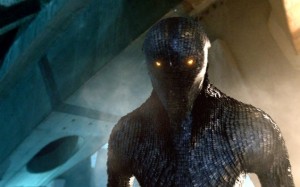
shape-shifting Sentinel seen in the future.
We see Mystique in the midst of her various activities leading up to her Assassination attempt. We meet a young William Stryker (the bad guy in X2, and Wolverine: Origins) who is played by yet another actor, a Seann William Scott look-a-like named Josh Helman. This, in addition to the fact that Wolverine didn’t wake up in the Vietnam war, just solidifies the fact that we all have to basically ignore everything that happened in X-Men Origins: Wolverine… anyway… of course we meet Trask who is played by Peter Dinklage. I have to say that part of me was distracted by Dinklage, who of course has (say it with me) achondroplasia – a common form of dwarfism. The character of Trask from the comics is listed as being 5’10” so this was kind of a bold casting move, but Di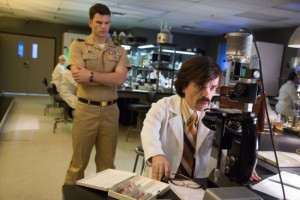 nklage has such an intimidating voice and such a large presence that it only took a scene or two before I was more than cool with having him playing the major bad guy. Though, as one friend pointed out, achondroplasia is a real-life mutation… seems kind of ironic.
nklage has such an intimidating voice and such a large presence that it only took a scene or two before I was more than cool with having him playing the major bad guy. Though, as one friend pointed out, achondroplasia is a real-life mutation… seems kind of ironic.
While they are successful in foiling Mystique’s initial attempt on Trask’s life, they make things worse as a camera catches the fight immediately following it which shows the world how dangerous Mystique, Magneto, and Beast all are. Magneto decides that it’s too risky to keep Mystique alive, so he tries to kill her, but she escapes into the crowd while Beast fights with Magneto. At the same time Wolverine is thrown for a loop when he sees young Stryker (who is responsible for giving him his indestructible skeleton and metal claws) and freaks out for a minute, causing us to see the future X-men toiling over Logan as he trashes about, accidentally stabbing Shadow Cat. The rest of the film we get cuts between the 1970s and the 2020’s to remind us of the ticking clock of the pending sentinel invasion upon the future X-Men.
The final confrontation takes place around the White House as Trask unveils his Mark-1 Sentinels – he doesn’t realize that the giant robots have been reprogrammed by Magneto. Upon their unveiling they attack the crowd watching. Xavier, who has over come his depression and is back in a wheelchair with his powers, is in attendance with a disguised Beast and Wolverine. At the same time Magneto uproots a local ballpark – I’m not sure which one – and drops it around the White House. This might be my biggest issue with this movie. The ball park around the White House thing seems totally unnecessary and does seem like just an attempt at some big visual at the climax. If someone had said “he wouldn’t attack the White House, the army would stop him!” right before he dropped the stadium around the white house it might’ve at least explained the logic, but even so – it’s not like the stadium doesn’t have doors. Or they didn’t have jets and paratroopers. It’s just easier to suspend reality around the White House battle.
At the same time, in the future the Sentinels have shown up and the real visual climax takes place as all the surviving X-Men battle to protect Shadow Cat and Wolverine from the shape-shifting Sentinels. Back in the 1970s Wolverine is sent to drown in the Potomac with several pieces of rebar stuck through his torso. Magneto is about the kill the president. (It was Nixon, so this would’ve been the best possible outcome for his career) when Mystique stops him. The whole event is on live TV and everyone sees a mutant save the president’s life. She then looks as if she might kill Trask, but instead drops the gun and walks away. In the future, everyone involved in the battle disappears. In the past we see Stryker later fishing a still-alive Wolverine out of the Potomac, but at the last minute it’s revealed that it’s not Stryker, but Mystique. This raises lots of questions regarding Wolverine’s origin story that I don’t have time to get into.
This is where the real spoilers are
I thought the movie might end after the battle. If it did it would be a fairly satisfying ending, but instead we see Logan wake up. We know it’s the future, not only because of the white stripe in his hair, but also because his alarm clock radio is holographic. He’s in the X Mansion and he gets up and walks into the hallway. He sees adult Beast (played by Kelsey Grammar) and Rogue (Anna Paquin). He sees Shadow Cat and Colossus teaching a class. Then he walks towards Xavier’s office to see… Jean Gray still alive. WHAAAAAT? She of course isn’t at all surprised to see him, as no one in this timeline knows about the darkest timeline. Then from behind the door comes Cyclops. What-what? And finally he sees Professor X who quickly realizes that this is the Logan he met as a young man, now returned from their first adventure together. So basically Bryan Singer just rebooted X-Men, but with the same cast. They could go anywhere from here. They could make more sequels starring the original cast, they could tell another Wolverine origin story. OR they could do what they’re going to do and keep going with the First Class cast and do a movie about the baddest bad guy in the X-Men cannon. The after-credits scene isn’t all that surprising given the name of the next X-Men movie: X-Men Apocalypse.
The after credits scene may not be a shock, but it is, however, a huge treat to a long-time X-Men fan. It starts in the desert sands, so even without the title of the next movie, we have a pretty good idea of where they’re going with this. As the camera moves up we see thousands of people worshipping a hooded figure who has his back turned to us and his hands raised. We soon realize that the figure is using some kind of telekinetic ability to build a pyramid. The camera swoops around him so that we can see his gray face and in the distance – four horsemen. Boom.
In Conclusion
For an X-Men fan, this might be a five out of five stars, but for a more casual fan it’s going to be hard to follow and there are several issues. As such I’ll take the average and give it four out of five stars. Really really fun for the 8 year-old in me, but I’m aware of the fact that it’s not the best film ever made. So far it is my favorite comic-book movie this summer and that is saying a lot as I really did in enjoy Captain America. Is it good for kids? It’s pretty violent and, as I mentioned you do get a glimpse of Hugh Jackman’s best side. Also the themes are pretty mature (I mean that literally by the way, some people use “mature themes” to really mean “juvenile themes that you don’t want your kid to hear about.”) with blurred lines of morality it is something you’d want to consider. I’d say definitely not for kids under 10 and pG-13 is probably a pretty good guide for this one.
Hope you enjoyed the review, if you did please like, and use my facebook comments below to add your thoughts. And, if you’re in the mood, please share it with your friends.
Do you want to get well? Trapped: A Victim Mentality
Introduction from May 2014
This past week at Frazer UMC, where I work here in Montgoemry, Levi Garnder, our minister of outreach, brought a great message from the text of John 5. This year we’re going verse-by-verse through the book of John and this past week we talked about Jesus healing the man by the pool. Here’s some of the Scripture from John 5:
After this there was a festival of the Jews, and Jesus went up to Jerusalem.
Now in Jerusalem by the Sheep Gate there is a pool, called in Hebrew Beth-zatha, which has five porticoes. In these lay many invalids—blind, lame, and paralyzed. One man was there who had been ill for thirty-eight years. When Jesus saw him lying there and knew that he had been there a long time, he said to him, “Do you want to be made well?” The sick man answered him, “Sir, I have no one to put me into the pool when the water is stirred up; and while I am making my way, someone else steps down ahead of me.” Jesus said to him, “Stand up, take your mat and walk.” At once the man was made well, and he took up his mat and began to walk.
Now that day was a sabbath. So the Jews said to the man who had been cured, “It is the sabbath; it is not lawful for you to carry your mat.” But he answered them, “The man who made me well said to me, ‘Take up your mat and walk.’” They asked him, “Who is the man who said to you, ‘Take it up and walk’?” Now the man who had been healed did not know who it was, for Jesus had disappeared in the crowd that was there. Later Jesus found him in the temple and said to him, “See, you have been made well! Do not sin any more, so that nothing worse happens to you.” The man went away and told the Jews that it was Jesus who had made him well.
John 5:1-15
This scripture is so poignant to me because of the seemingly silly question Jesus asks in verse six: “Do you want to be made well?” You’d think that would be a no brainer, that anyone would see this man and know that just by looking at him that he would desire nothing more than to be made well. Jesus knew enough to know that it wasn’t the case. I think the detail of that question and the answer are in scripture intentionally to teach us about being victims of our circumstances, because even more interesting is the man’s answer. He doesn’t say “yes. of course. duh. what kind of question is that?” He makes an excuse as to why he can’t be made well. He says “I have no one to put me into the pool when the water is stirred up and while I’m making my way someone else steps down ahead of me.” In this answer is his honest answer: “what I really want is for you to feel bad for me.” Because this man had a hard life. He had been sitting by this pool begging for 38 years. It’s quite likely that he survived on hand outs from the others who came by to step into the pool. It was likely that the people walking by felt bad for him and he realized that if he actually were to be healed that as wonderful as it might be, then he might have to do real work. So did he want to be healed? Deep down, of course. But the false-self that he had created depended upon his sickness to maintain his way of life.
 If we’re honest, we like to use their painful history as a tool, or worse, a weapon. We lord it over people or try to use it to further our careers and social standing. In reality this kind of use of our pain is almost always toxic and usually won’t create any sustaining foundations on which these structures can last. This is why many popular musicians have such tragic lives. They often start off with the usual issues we all have: issues with their family, faith, & finances. Once they’ve worked out their finances they have a choice to move onto their family and faith or they can start inventing new problems. They don’t want to be made well.
If we’re honest, we like to use their painful history as a tool, or worse, a weapon. We lord it over people or try to use it to further our careers and social standing. In reality this kind of use of our pain is almost always toxic and usually won’t create any sustaining foundations on which these structures can last. This is why many popular musicians have such tragic lives. They often start off with the usual issues we all have: issues with their family, faith, & finances. Once they’ve worked out their finances they have a choice to move onto their family and faith or they can start inventing new problems. They don’t want to be made well.
One of my family’s favorite movies is film based on a book by the same name Cold Comfort Farm. It’s rich comedic satire of Jane Austin’s writings – and it cleverly lampoons many of the common plot devices she and other similar authors use. In the story a young woman goes to live with her strange relatives. Her great aunt is up in her room all the time and never leaves. When asked she says “I saw something nasty in the woodshed.” And as comical as this might sound it’s become a reference that my whole family understands. If one of us refers to someone who “saw something nasty in the woodshed.” It means they’re hanging onto something unfortunate in their past. They don’t want to be made well.
Ken Roach and Jerrod Dorminey Captured it well in their original Blues Song “the Bethesda Blues.” Featured in this past week’s worship service.
https://www.youtube.com/watch?v=7zTF5LZyBYE
The rest of this post I wrote three years ago. It was one that got several comments on my old blog, including one asking me how someone can get out of the victim mentality. I was surprised at the question but also frustrated that I don’t have a good answer that would fit every situation. The best thing I can offer is this: If someone wants to get better, they can get better. That’s why I believe the man by the pool truly wanted to get better, even if he was playing the victim. But there are those who want to be victims their whole lives. I really believe that prayer is the only thing that can help someone who doesn’t want to be made well. Divine intervention then counseling either from a professional or a wise mentor. Some people just want to cling to their sickness and make excuses when they should cling to Christ and defy everyone’s expectations.
Original Post from June 2011
A great way to stay trapped Perhaps the greatest lesson that my father taught me about life from a early age is that a victim mentality gets you nowhere. Likely everyone that regularly reads my blog would agree with me, but recently I saw some posts on Facebook that reminded me that some people earnestly believe that it is perfectly acceptable for individuals to rest on the excuses generated out of whatever unfortunate circumstances their life has given them. To those people I’d like to say: that’s perfectly fine. From a secular point of view it is totally acceptable for you to use your past as an excuse for your current behavior, if you wish to stay trapped your whole life. That’s perfectly ok, no one will force you out of captivity. A person in a victim mentality is much like a person who has been beaten, bruised and forced into a cage. Later, whether days or years, the bruises heal and someone will come to them with the key to their escape. Most will not use the key, however. Why? Because once you’re free you no longer have the excuse, you have to take full responsibility for yourself. Most people would rather be able to lean on the excuse of what has been done to them; garnering sympathy and demanding that people be sensitive to what has happened to them.
Before I continue, I should specify that I do believe that there are many reasons for a person to be a victim that they truly cannot help. Mental Illness or chemical imbalances caused by genetics are among them. But just as those people must choose to submit to therapy and/or medication; those who have chosen to be defined by their most tragic and painful moments, they need to eventually lay it all down to be truly free.
I also should say that I do believe in being as sensitive to people as is reasonable in every situation. I can’t begin to imagine the tragedy through which some people have lived and I would never deny them grief, anger, or mourning; all three of which are holy emotions expressed by Jesus himself. However, there is a massive difference between feeling and expressing a holy emotion and allowing yourself to fall victim to your emotions. The difference is in this phrase: “Because ______ happened to me I must always react by ______” When you say that you are becoming victim whether in a small or large way. By contrast each time you say “Despite the fact that ______ happened to me, I will choose to ______” you are choosing to not be victimized.
The Bible tells me so
Please understand that I’m not so arrogant as to say that people shouldn’t be affected by the tragedies of life. I don’t pretend to understand all of the different causes of strife in the world or the pain that people have experienced, but I do know that from a scriptural worldview its impossible to say that a victim mentality is acceptable.
I think you ought to know, dear brothers, about the hard time that we went through in Asia. We were really crushed and overwhelmed, and feared we would never live through it. We felt we were doomed to die and saw how powerless we were to help ourselves; but that was good, for then we put everything into the hands of God, who alone could save us, for he can even raise the dead. And he did help us, and he saved us from a terrible death; yes, and we expect him to do it again and again. 2 Cor 1:8-10 Living Bible
Or, Perhaps more to the point. . .
Now I rejoice in my sufferings for your sake Col. 1:24a
There are many many more scriptures about rejoicing in suffering. So from a scriptural standpoint, we see Paul – beaten, tortured ‘doomed to die’ and what does he say? “That was good.” Wait, what? “Powerless to help ourselves” “that was good” “overwhelmed” “that was good.” “crushed” “that was good.” seriously. It’s only been in the last several years that I’ve come to realize this. Christians are blessed with the hope in Christ and the ability to say that our suffering only brings us closer to Him and by suffering for Him, we take part in the fellowship of His suffering. We go from “that was bad” to “that was hard” to “that was good.”
Is this some kind of sickness? Perhaps masochism? By no means! Looking back and saying something was ‘good’ is far different then deriving pleasure from it. Again, there is nothing wrong with anger and mourning. The only reason why Paul is able to look back at the bad times and call them good is because he realizes they brought him closer to Christ. He realizes that Christ’s resurrection power is at work in our lives, but to access that power we have to die. Think about that for a minute. Its easy for us to think of Christ’s death on the cross as the great tragedy of history and his resurrection as the restoration of that tragedy. Christ’s resurrection wouldn’t have been possible without His death. A Christian view of suffering is simply realizing that without death there can be no resurrection.
On the practical end of things…
Even if you’re not looking at this from a scriptural perspective, say you’re an agnostic or a secular humanist, then look at it from the purely practical end of things. If we decide that there are some things in life that a person cannot be expected to recover from, some wounds that cannot be healed; that’s fine, but do you really want to work with someone who’s single greatest aim in life is to make sure everyone is sensitive to their life’s tragedies? After a while there must be a reasonable expectation of growing from your past, and becoming responsible for your present. I don’t say ‘moving on’ because I think that insinuates that you must ignore your past, not at all, instead you grow from it and become stronger than ever.
Steven Covey, the writer of Seven Habits of Highly Effective People, talks about this in the first Habit. Which is “Be Proactive.” He simply states that a part of being proactive is taking responsibility for yourself and your behavior. He suggests that the main meaning of being responsible is being able to choose your response.
Most people who have a victim mentality get angry at the insinuation that they are somehow to blame for their attitude. They act as if that’s tantamount to being told that they are to blame for the tragedy in their life or their genetic make up. That’s a huge leap in logic. Between stimulus and response there is a narrow space where you can choose. You’re not Pavlov’s dog, forced to salivate by every bell that rings. You’re not a programmed machine, who’s brain will always produce the same reaction given the same set of circumstances.
I recently had the pleasure of hearing a lecture by Ben Carson. Dr. Carson is the preeminent pediatric neurosurgeon active today. He’s participated in several firsts in his field including the first separation of siamese twins that were conjoined at the head. This is featured in a movie called “Gifted Hands” starring Cuba Gooding Jr. as Dr. Carson. In 2008 Dr. Carson was awarded the presidential medal of freedom, the highest civilian honor in our nation. That’s impressive, but what’s more impressive is that Dr. Carson came from a low-income single parent household in Detroit. At a young age his parents divorced and his mother struggled to find employment as she couldn’t read – the only work she could maintain was that of a house keeper where Ben would later say “She observed that successful people spent a lot more time reading than they did watching television.” And she implemented a rule that her two sons would read two books a week from the library. You can read more about
Ben Carson’s upbringing on NPR’s website.
The reason why the victim mentality is so pervasive is because there is only one alternative: work. It takes work to overcome the setbacks, the emotional stresses, the tragedies of life. No one would’ve blamed Ben Carson for being a below average student, he had a number of things against him. But his mother chose to fight that and later he chose to fight that as well, working hard to get into med school and then working hard to become the best doctor he could be. That’s because they chose not to be victims of their circumstances. Most people can’t even admit that they’re choosing to be victimized because If you admit that you can do something about it and choose not to do something about it, it becomes your fault. I wouldn’t be writing about this if it weren’t a struggle for me also, but one thing I’ve realized is that once you are real with yourself about where you are choosing to be victimized then you can start to allow the solution permeate throughout your life.
Personally…
I’ve struggled with having a victim mentality about many different things. There are some ways in which I continue to deal with it. One small example is the fact that I’m not an athletic person and most of my growing up years I allowed myself to be victimized by that, but as I grew up, I began to fight the impulse to feel victimized and I stepped out of my comfort zone and tried new activities. Now I have a whole list of sports and activities that I really enjoy, even if I’m not the best at them. Stepping out in this manner has opened so many opportunities to me that I would have never had if I had rested on the laurels of victimization. I think the message paraphrase of the Bible phrases paul’s words in Philippians well:
I’m not saying that I have this all together, that I have it made. But I am well on my way, reaching out for Christ, who has so wondrously reached out for me. Friends, don’t get me wrong: By no means do I count myself an expert in all of this, but I’ve got my eye on the goal, where God is beckoning us onward—to Jesus. I’m off and running, and I’m not turning back. Phil 3:12-14
I think one of the mistakes we make when trying to overcome our victim mentality is the idea that we need to have it all figured out, that we need to somehow be totally fixed before we relinquish our victim status. In reality, we just have to admit that we don’t always know exactly what the path to healing is going to look like and we need to trust that it ends at the feet of Jesus. Whatever your excuse is for not living a full and healthy life, that’s not God’s will for you. I can tell you he wants you to take hold of you inheritance now. Yes you have eternal life in terms of length, but you also have abundant life in terms of height and depth, so stop making excuses and grab hold of the abundance that Christ has given you.
The Amazing Spider-Man 2: A Review (spoilers are marked)
Preamble (a brief review of the Amazing Spider-Man):
It was midsummer 2004 when I went to the midnight showing of Sam Raimi’s Spider-Man 2 Starring Tobey Maguire and Kirsten Dunst. I was a huge spiderman fan starting when I was eight with the 1994 Spider-Man cartoon. I still have a copy of “The Sensational Spider-Man #0” which has appreciated in value by an impressive 98% making it worth almost $3. I really enjoyed the first Spider-Man movie, so I was primed to be a huge fan of Spider-Man 2. Many think it was the best of the original trilogy. It was one of the few examples of a sequel being arguably better than the original.
So here we are, ten years later – what about this new second installment? You should first know that I didn’t dislike the first Amazing Spider-Man movie, but that It didn’t knock my socks off either. I so identified with Tobey Maguire; he was so perfectly uncool – so totally nerdy that I identify with the guy far more than Andrew Garfield. But the biggest issue with the first chapter of this new Spider-Man is that we basically knew what was going to happen for the at least first half of the movie because we’d already seen it. Getting bitten by a spider, gaining powers, not stopping the guy that would go on to kill uncle Ben – that was all necessary to establish the “new universe” but we as an audience didn’t need to see it again. It was good. It was well done. It was arguably better than the first time around, but since it had been done well before (and just a short ten years before) it made the movie feel boring to me.
I recently re-watched it and found that I enjoyed it much more the second time around. Emma Stone is really what makes the movie. Andrew Garfield is great, but seeing a love interest that is as invested in Spider-Man as the hero himself is the strength of the movie. Andrew Garfield is also better at the comedic quipping that I do especially love about the character of Spider-Man. So you know that I enjoyed the first movie, but not as much as the original trilogy.
Down to business
So how did I like the sequel? Basically I found it to be exactly what it had to be, but that doesn’t mean everyone will like it. The movie opens with the same scene that the first movie opened with, only instead of being told from the perspective of young Peter Parker – it’s told from his father’s view. We then follow him after his disappearance to find out about what happened to him after he dropped peter off with Aunt May and Uncle Ben. There’s a high adrenaline scene in which we find out that Richard Parker has some kind of information on his laptop that he’s transferring to a secret location as he and his wife are fleeing the country. I won’t totally spoil how the scene ends, but it is action packed and I will say (possible spoiler) it is still unclear as to exactly what happens to Richard Parker, though we’re certainly lead to believe that he may not be alive. 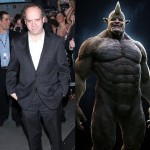
Back to the present day and Spider-Man is in the middle of stopping Paul Giamatti (who I love for not being above this bit role) from stealing some plutonium that, surprisingly, has nothing to do with the rest of the movie’s plot. I thought this was odd because to paraphrase Chekov, “If you show weapons-grade plutonium in the first act then it must make someone a super villain in the third act.” But I suppose to paraphrase the mis-quoted Freud, “sometimes weapons-grade plutonium is just weapons-grade plutonium.” This scene is basically just setting up how life normally is to Spider-Man/Peter Parker these days. Meanwhile Gwen Stacy is giving her valedictorian speech at their high school graduation, for which Peter is running late. He makes it just in time. Shortly after we have a little teen angst as Peter and Gwen re-break-up because peter keeps on seeing Gwen’s Father everywhere. At one point they’re even nice enough to roll the clip from the last film of the dying Captain Stacy making Peter promise to not get involved with Gwen.
Here’s where things get complicated.
Here’s where the plot effectively splits into four different mutant sub plots. 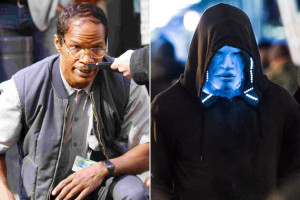 At the same time we’re introduced to Max Dillon, played by Jamie Foxx. Max is saved by Spider-Man and develops a pitiful obsession with him. We’re shown that Max is a nobody who was cheated by his employer, Oscorp, when they stole one of his ideas for a power plant that is now powering all of New York City. He’s such a sad person that when he falls into a vat of electric eels and gains electric powers we’re almost on his side.
At the same time we’re introduced to Max Dillon, played by Jamie Foxx. Max is saved by Spider-Man and develops a pitiful obsession with him. We’re shown that Max is a nobody who was cheated by his employer, Oscorp, when they stole one of his ideas for a power plant that is now powering all of New York City. He’s such a sad person that when he falls into a vat of electric eels and gains electric powers we’re almost on his side. 
Then there’s the on-going love story with Peter and Gwen. The fact that he checks on her every day even though he’s not maintaining contact with her is not at all creepy because it’s Andrew garfield. Though if Paul Giamatti had been in the role of Spider-Man I think they would’ve called this “stalking.” When they finally go on a date again (less than 20 minutes of screen-time after they broke up) we add the tension of the fact that Gwen is considering going to Oxford for college. (The one in England.) There is always the underlying tension of Peter’s promise to Gwen’s father to stay out of her life.
 Plot number three comes in the flavor of the movie’s most interesting new Character, Dane DeHaan playing the new Harry Osborn who, of course, is a mixture of Harry Potter and Jason Bourne. This iteration of Harry Osborn immediately has more pathos than James Franco’s Harry. Because 1) He’s not James Franco. 2) –possible spoiler– His dad dies at the beginning of the movie 3) We find out he is dying of the same thing. Harry wants to pick up where his father’s evil company left off in trying to discover a cure for the made-up disease that’s killing him. For some illogical reasons Harry believes that Spider-Man’s blood might be the answer to his problems. Because. . . spiderman. This is complicated by the fact that Harry and Peter were childhood friends. While DeHann has more gravitas as a performer than Franco, he sounds and looks like he’s about 15 which took me a while to get over since he’s promoted to CEO of a large company after his first scene.
Plot number three comes in the flavor of the movie’s most interesting new Character, Dane DeHaan playing the new Harry Osborn who, of course, is a mixture of Harry Potter and Jason Bourne. This iteration of Harry Osborn immediately has more pathos than James Franco’s Harry. Because 1) He’s not James Franco. 2) –possible spoiler– His dad dies at the beginning of the movie 3) We find out he is dying of the same thing. Harry wants to pick up where his father’s evil company left off in trying to discover a cure for the made-up disease that’s killing him. For some illogical reasons Harry believes that Spider-Man’s blood might be the answer to his problems. Because. . . spiderman. This is complicated by the fact that Harry and Peter were childhood friends. While DeHann has more gravitas as a performer than Franco, he sounds and looks like he’s about 15 which took me a while to get over since he’s promoted to CEO of a large company after his first scene.
Plot four involves Peter’s discovering the truth of his father’s involvement in Oscorp and what his research actually resulte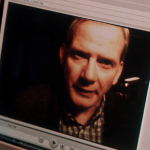 d in. This also answers one of my biggest problems with the first “Amazing Spider-Man.” With the first movie I was bothered by the fact that Peter entered into an easily accessible room full of thousands of spiders and was bitten by one and got powers. I wanted to know why no one had been bitten before or since by these spiders and gotten powers. Well it turns out that when Richard Parker created these “Human/Spider Hybrids” he used his own DNA so only someone with his same genetic makeup could reap the benefits of their genetically enhanced venom. So there you go. That’s why peter was the only one who could get powers.
d in. This also answers one of my biggest problems with the first “Amazing Spider-Man.” With the first movie I was bothered by the fact that Peter entered into an easily accessible room full of thousands of spiders and was bitten by one and got powers. I wanted to know why no one had been bitten before or since by these spiders and gotten powers. Well it turns out that when Richard Parker created these “Human/Spider Hybrids” he used his own DNA so only someone with his same genetic makeup could reap the benefits of their genetically enhanced venom. So there you go. That’s why peter was the only one who could get powers.
If that sounds like a lot…
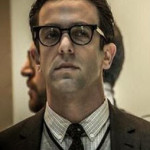 …that’s because it is. It’s a little ridiculous and really it probably would’ve been fine without one of the plots. Many people will find it too long. Many people will find it too convoluted. In many
…that’s because it is. It’s a little ridiculous and really it probably would’ve been fine without one of the plots. Many people will find it too long. Many people will find it too convoluted. In many  ways it could be compared to The Dark Knight in that it is darker, than the first and has a villain that doesn’t show up until the movie feels like it’s already supposed to be wrapping up. But the thing I liked about it is that it felt more like a multi-part story within the ’94 Spider-Man series. Because there were several seemingly unrelated bad guys. It’s also fun because they introduce us to other characters we haven’t seen before on the big screen, but are long-time Spider-Man regulars, Like Alistair Smythe, played by BJ Novak, who later goes on to become “The Spider Slayer” and Felicia Hardy, played by Felicity Jones, who eventually becomes Black Cat.
ways it could be compared to The Dark Knight in that it is darker, than the first and has a villain that doesn’t show up until the movie feels like it’s already supposed to be wrapping up. But the thing I liked about it is that it felt more like a multi-part story within the ’94 Spider-Man series. Because there were several seemingly unrelated bad guys. It’s also fun because they introduce us to other characters we haven’t seen before on the big screen, but are long-time Spider-Man regulars, Like Alistair Smythe, played by BJ Novak, who later goes on to become “The Spider Slayer” and Felicia Hardy, played by Felicity Jones, who eventually becomes Black Cat.
The point where this all comes to a head is after Spider-Man tells Harry that he won’t give him any of his blood, and Oscorp tries to oust Harry just as he’s been told that some of the genetically enhanced spider venom was kept after the spiders were destroyed, and Harry discovers that Max (now Electro) is being held at Revencroft, the Arkham Asylum of the Marvel Universe. After Harry unleashes Electro and forcibly takes Oscorp back, he then enters a secret room at Oscorp that basically has the power sources of all the remaining spider-man villains; Doc Oc’s arms, Green Goblin’s glider, the Rhino’s suit, and some other things. When harry finds the remaining venom and injects himself with it he turns into the Green Goblin and hops on the glider like he’d done it a million times before. That part seemed a little rushed to me.  All the while Electro has pulled the plug on the entire City of New York. We’re reminded of how terrible this would really be as incoming planes can’t contact the tower and Aunt May is struggling at a hospital to care for patients. Then we come to the final battle with Electro, but it’s really pretty amazing how little we care about him at this point, considering he’s played by the most famous person in the movie. Gwen shows up to help and actually comes up with the idea that finally defeats electro. At this point a normal movie would end, but not this film. We’ve still got another bad guy to defeat.
All the while Electro has pulled the plug on the entire City of New York. We’re reminded of how terrible this would really be as incoming planes can’t contact the tower and Aunt May is struggling at a hospital to care for patients. Then we come to the final battle with Electro, but it’s really pretty amazing how little we care about him at this point, considering he’s played by the most famous person in the movie. Gwen shows up to help and actually comes up with the idea that finally defeats electro. At this point a normal movie would end, but not this film. We’ve still got another bad guy to defeat. 
And the biggest spoiler of all
You’ve been warned, the next few paragraphs contains the biggest spoiler of the movie. After the green goblin shows up and puts together the fact that Peter Parker and Spider Man are the same person because Gwen Stacy is hanging out with Spider-Man. (a stretch, I grant you.) they fight a while. Here’s the issue with this: We didn’t care as much about the battle with Electro, because Harry had been established as the main antagonist. Now we’re a little battle-weary by the time Harry actually shows up as the Goblin and so we don’t care as much about the battle that we were more curious about in the first place.
Then we come to the conclusion of the fight as the Green Goblin drops Gwen off from a high place. Spider-Man finally manages to dispatch with the Goblin, knocking out so easily that you question why he didn’t do it before. Gwen is falling amidst the debris as Peter shoots a web down to her we shift into that combination of slow-motion accompanied by a particular dramatic theme that tells you someone is going to die. Gwen hits the ground milliseconds before the web makes it to her. She hoists up and Peter lands by her. For a few moments I was convinced that she was going to wake up. I’m rarely really shocked by a movie – especially a superhero movie, but this one surprised me as I realized – they killed Gwen. Matt Williams reminds me that this is canonical, that Gwen died in a manner very similar to this in a issue of the comic in the 70’s, but it still is a bold choice for the mood of Spider-Man.
The following scenes show peter staring at Gwen’s grave across multiple seasons. We’re told that Spiderman hasn’t shown up for five months. You read that right. The movie’s timeline continues five months after the climax of all the plots. The final scene is actually quite fun, as Spider-Man finally shows back up in a tear-jerking moment and fights Paul Giamatti again, now in the Rhino battle suit.
The denouement feels a little like Return of the King because it has multiple endings. But that is a better alternative than concluding on the note of despair that it could’ve closed out with. Marc Webb chose to not end the movie in the dismal hopelessness that we were left with at the end of The Dark Knight. I’m very glad he did. Spider-Man isn’t about indulging in the darkest moments of life. Even though he has some marked similarities to Batman, I appreciate the fact that this installment of Spider-Man, while the darkest one ever, sticks around long enough to leave us with some hope. 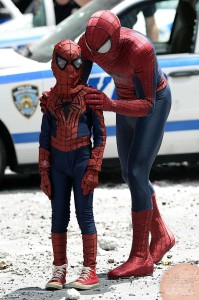
So what of it?
Ultimately in spite of the issues I have with it, I find it to be a fun movie. It over-stays its welcome by about 20 minutes, but I care enough about the characters to hang on. The character of Gwen really does carry much of it for me still. I did really enjoy Spider-Man’s quipping and antics in this one. It feels very much like the recent cartoon “Ultimate Spider-Man” which takes place within a similar continuity and is a lighter fare than most incarnations of the web-head. So while it does go darker than other iterations, it maintains an appropriate level of humor to relieve the tension.
Things I would’ve like to have seen: The deleted scene featuring Mary Jane meeting Gwen Stacy would’ve been fun. It’s pretty well known that Divergent star Shailene Woodley filmed a scene as Mary Jane Watson that was cut. It would’ve been fun to see this set up for the next movie. I hope Woodley isn’t too busy for the next Spider-Man, but it seems likely she won’t have time with her current schedule filming the Divergent sequel movies. I also would’ve been glad for them to bring back Norman Osborn at the end, revealing that he faked his death so that Harry would try the serum on himself. It seems like something Norman would do and also it would open up some interesting possibilities for the next chapter.
I also would’ve been glad for them to bring back Norman Osborn at the end, revealing that he faked his death so that Harry would try the serum on himself. It seems like something Norman would do and also it would open up some interesting possibilities for the next chapter.
I’m going to give this one 3.5 out of 5 stars, but only because I’m rounding up. It’s definitely enjoyable and definitely worth seeing, but not without it’s issues. The pacing is awkward – the first half felt slow as it was spent setting up the four plots. The second half felt rushed in resolving them, the final few minutes felt somewhat superfluous after multiple battles had been resolved. But the battles are lots of fun and in comparison to the supremely awkward pace of Spider-Man 3, it was a paragon of storytelling. Go see it for yourself and if you already have seen it, do you agree? Do you disagree? How’d you like it?
The Muppets Most Wanted: Movie Review
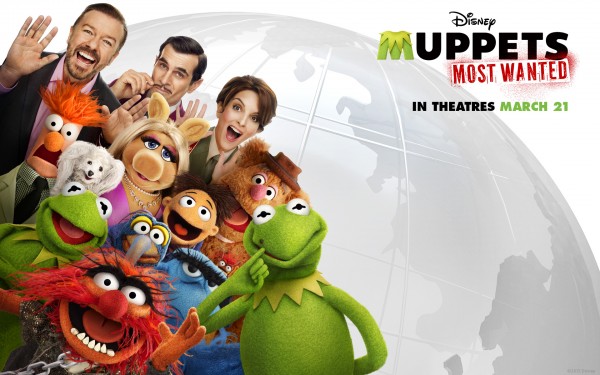
The Meta-verse almost imploded on herself
I love meta humor. I really do. I love it when a movie references itself in a way to make clear that we all know we’re watching a movie. It’s probably because I don’t like anyone or anything to take anything too seriously. The Muppets never take themselves seriously – because…muppets!
When I say meta, this is what I mean: This movie begins where the other movie left off. I don’t mean in a thematic way – or even in a plot way. I mean this movie starts at the second the last movie ends and moves on as if they just finished shooting that movie and now are shooting another one. They then make reference to the number of movies they’ve done and refer to the last movie several times – by saying “In the last movie…” I love this stuff. Since I grew up on Muppet movies and several lines from the movies have made their way into my family’s vernacular, I’m enjoying the fact that the Muppets know we’re all aware that this is the seventh (or eighth, depending upon how you count) muppet movie sequel. So right off, I love the humor in this movie.
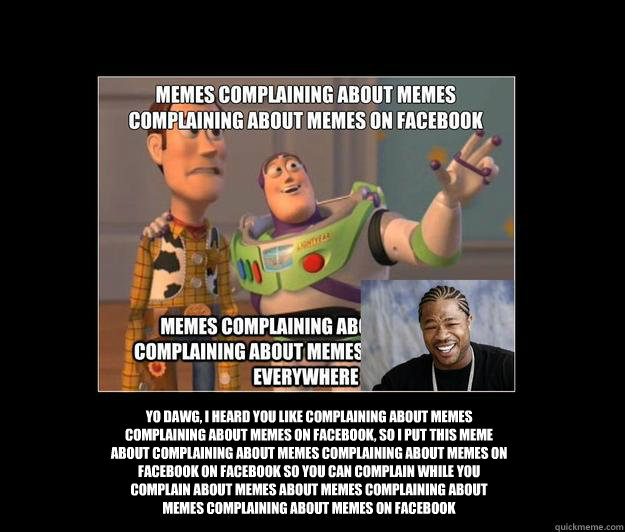
If you get this, then you get meta humor.
sorry that was basically unrelated.
The Story? Ohhhh the story!
While I could just get lost telling you about all my favorite gags and cameos, what’s funny is that this probably has one of the more solid Muppet movie plots (aside from Muppet Christmas Carol and Muppet Treasure Island because they are based on classic literature.) In this story, after the success of the last Muppet movie the Muppets decide to go on a European tour. That’s when they’re approached by Ricky Gervais’ character, Dominic Badguy. He explains that the last name is french and it’s pronounced “Bajee.” He says he’ll manage their European tour and despite Kermit’s objections they decide to follow his lead. At the same time another frog named Constantine (that looks exactly like Kermit except for a small mole on his upper lip) escapes from a Russian prison and finds Kermit and replaces him. We soon discover that Dominic and Constantine are partners in crime and that the tour is a cover for a series of heists they’ve planned.
The plot then splits into three. First off, you have Constantine and Dominic with the rest of the Muppets as they go on their tour. At first the muppets think that things are great as suddenly this new “Kermit” is letting them do whatever they want and it appears that they’re playing to sold-out crowds. Meanwhile, the real Kermit is stuck in the Russian Gulag, an all-star prison that has Tina Fey as the commandant as well as Ray Liota, Danny Trejo (as “Danny Trejo” – not “himself” I’m serious, look at the credits) and even a brief cameo from Tom Hiddleston. As they realize that Kermit is not Constantine Tina Fey decides to use Kermit’s skills to put on a show staring the prisoners. And finally we have the undercurrent of Interpol inspector Pierre Napoleon (played by Ty Burrell channeling Peter Sellers) and Sam Eagle searching for whomever is responsible for these heists – the mysterious thief known as “The Lemur,” who we know to be Dominic.
As things unfold it becomes obvious that the gang doesn’t do so well without Kermit’s guidance and a few of them eventually grow suspicious of Constantine. Kermit manages to stage a breakout during the middle of the show he’s putting on in the Gulag while at the same time Sam Eagle and Pierre follow the evidence to Constantine and Dominic. You can see how the three plots converge around the same time and hilarity ensues.
let’s talk about some cameos
Listen, I won’t spoil all the good surprise cameos for you, but I will say that this Muppet movie probably has more cameos than any other Muppet movie so far. Some of them are so quick that you may not even notice them. Others are so poetic you’ll wonder why the joke hasn’t been made before. My favorite part of the cameos is that it shows me the people in hollywood who are willing to poke fun at themselves and play a bit part for the sake of a short joke. It shows you the power of comedy and the star power of the Muppets. Who else could get Sean “Puffy” Combs, Lady Gaga, or James McAvoy to show up for what I’m sure was a whole day just to shoot a bit joke. That’s pretty amazing.
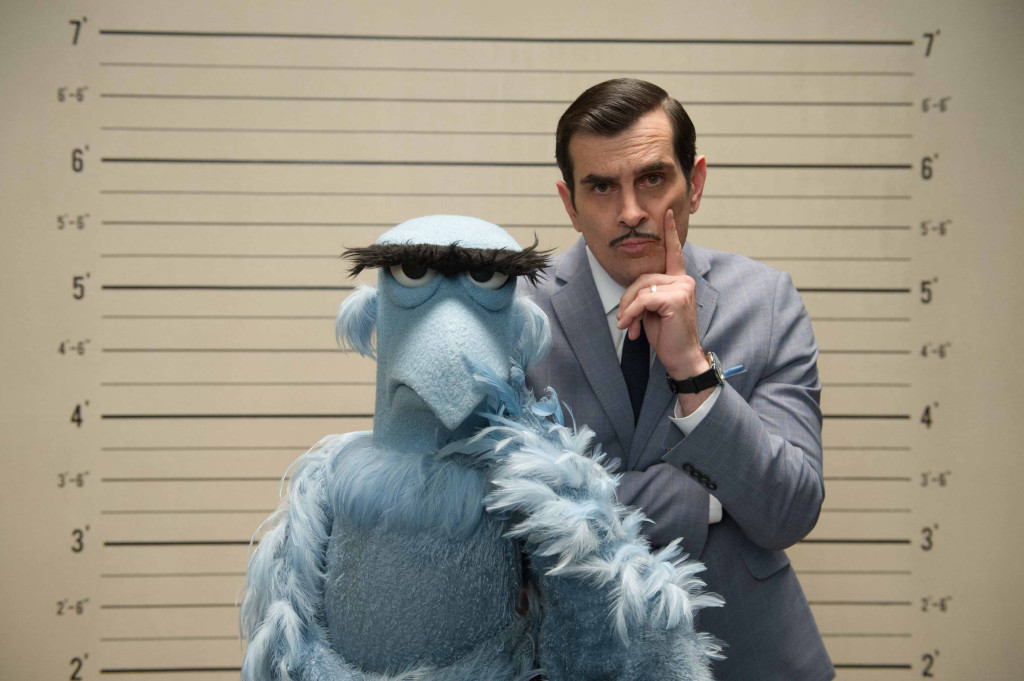
The Rest of the Cast
I don’t have to tell you that Tina Fey was awesome, because Tina Fey is going to be awesome in anything she does. I was a little worried when I saw that the human element in this movie would be filled out by Ty Burrell and Ricky Gervais. Mainly because I’m not a big fan of Ty Burrell and I think Ricky Gervais has all the appeal of a rusty spatula being shoved in one’s ear. But, despite my apprehensions, they were both perfect for their respective roles. Ty Burrell was lovely as the french detective who takes six hour lunch breaks whenever he feels like and an eight week vacation right before the case is solved – a rare cheap shot to europeans that I really enjoyed. Since Ricky Gervais plays the very overt bad guy in this one we’re never supposed to like him, so I actually found it easier to enjoy his performance. Having the added benefit of the Disney-friendly script that comes with any Muppet movie, was helpful in this measure too.
Family, fun for the whole
As far as all that goes, I’d say that you needn’t worry about this being an issue for your kids. There aren’t any objectionable jokes and really not any scary moments. Even at a few moments where you’d expect it to get scary it immediately backs off and becomes funny again. It’s just a fun ride. I wouldn’t have any qualms about my six-year old nephews seeing it. The only down side is that – like all Muppet movies – kids won’t be able to appreciate the brilliance of much of the humor. It’ll be funny to them, but it’ll be funnier to their parents who are still young at heart.
Over all
It’s great. Great fun, good story, good characters. If there was a weak side I’d say that the music wasn’t as good as it has been in the previous Muppet movies, but that’s a tall order since in the eight (or nine) muppet movies they’ve made now there have been some outstanding musical numbers. The previous offering, the Muppets, even had a contender for best song at the Oscars. The songs, however were no less fun and with references to A Chorus Line and a cameo from a certain Canadian diva, the musical portion of the film is still very rich in its quality and humor.
From a Christian perspective I thought it had some interesting points. The muppets let their leader, Kermit, be replaced by something totally different from Kermit and none of them stopped to look and see what had happened. They also thought they were happier because they were all getting to do what they wanted to do, but the show was a disaster and they eventually realize that without Kermit at the helm, their performances suffer. To me, this is a powerful illustration about who we let take the lead and how we all have to realize that we can’t always have our way, but if we’re willing to submit to God’s authority that we can end up getting something better: unity and community.
So grab your family, grab your wife, grab your kids, and grab your husbands because you’re gonna want everyone to enjoy this one together. 5/5 stars, not because it’s the best movie ever, but because there plain ain’t nothing wrong with it.
